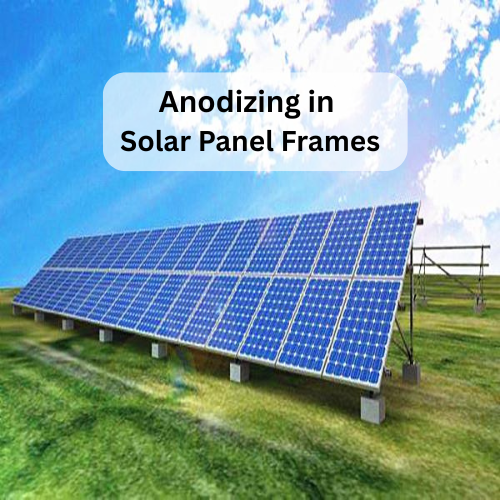As the world accelerates toward renewable energy solutions, solar photovoltaic (PV) systems are at the forefront of global energy transformation. But behind the solar cells themselves lies a crucial enabler of performance and longevity: anodized aluminium. Known for its exceptional corrosion resistance and surface durability, anodized aluminium is essential for various structural and functional components in solar applications.
In this article, we explore how anodizing technology contributes to efficiency, cost-effectiveness, and reliability across solar projects.
What Is Anodizing and Why It Matters?
Anodizing is an electrochemical surface treatment that thickens the natural oxide layer on aluminium. This process:
- Creates a controlled, highly durable barrier layer
- Enhances corrosion and UV resistance
- Allows for decorative or functional finishing without paint or coating
For solar systems that operate in high-UV, high-humidity, or coastal environments, anodized aluminium components offer extended operational lifespans and lower maintenance overhead.
Applications of Anodized Aluminium in the Solar Industry
1. Solar Panel Frames (Module Borders)
Solar panel frames, typically made from extruded aluminium, benefit tremendously from anodizing. When anodized, these frames gain:
- Improved mechanical stability under wind and snow loads
- Resistance to galvanic corrosion, especially important when panels are mounted to dissimilar materials
- A non-conductive surface layer, reducing the risk of leakage currents or potential-induced degradation (PID)
A matte or gloss anodized finish also enhances the visual appeal of solar installations in architectural settings.
2. Mounting and Racking Systems
Anodized aluminium is the material of choice for mounting structures due to its high strength-to-weight ratio. The anodized layer:
- Resists oxidation and rust even in saline coastal conditions
- Prevents structural fatigue over 20–25 years
- Reduces lifecycle costs by minimizing replacements and maintenance
This makes anodized mounting rails and brackets ideal for both rooftop and utility-scale installations.
Economic & Technical Benefits
Cost Reduction Potential
- Low maintenance and longer life reduce operational expenses
- Lightweight anodized aluminum cuts down on transport and installation costs
- Anodizing enables mass customization (color, texture) without extra coating steps
Technical Performance
- High dielectric strength of the anodized layer improves electrical safety
- Porous anodic layers provide excellent adhesion for additional surface treatments or functional coatings
- Thermally stable under prolonged sun exposure, avoiding deformation or discoloration
Sustainability & Lifecycle Advantages
Anodizing is a low-environmental-impact process when controlled properly. It doesn’t emit VOCs and the aluminum remains 100% recyclable after its service life. Since anodized parts are more durable, fewer replacements are needed, translating to a smaller carbon footprint over decades.
Final Thoughts
Anodized aluminum is not just a structural component — it’s a performance enabler in modern solar technologies. From mechanical support to optical enhancement and even next-gen photovoltaic interfaces, anodizing delivers unmatched durability, efficiency, and cost-effectiveness. As solar deployment scales worldwide, anodized aluminum will continue to be a foundation of sustainable, high-performance energy systems.
Frequently Asked Questions – FAQs
You can contact us directly by emailing corporatecommunications@growel.com. Our team will be happy to assist you with your specific requirements, technical questions, or service inquiries.
Please visit our Anodizing Solutions page. Scroll to the bottom of the page — you’ll find a simple inquiry form there. Kindly fill it out, and our team will contact you shortly to assist with your requirements.
Yes! For any queries related to Anodizing, please reach out to corporatecommunications@growel.com. We’ll ensure your query is resolved promptly.



